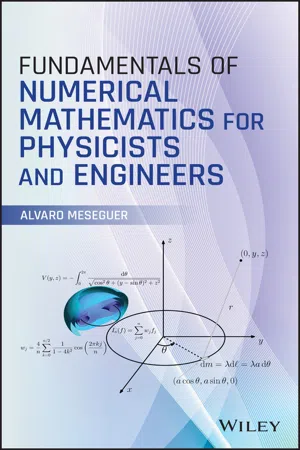Mathematics
Integrating Polynomials
Integrating polynomials involves finding the antiderivative of a polynomial function. This process requires applying the power rule for integration, which involves raising the exponent by 1 and dividing by the new exponent. The result is a new polynomial function with a constant of integration added.
Written by Perlego with AI-assistance
Related key terms
4 Key excerpts on "Integrating Polynomials"
- eBook - ePub
- Mary Jane Sterling(Author)
- 2018(Publication Date)
- For Dummies(Publisher)
Chapter 7Plugging in Polynomials
IN THIS CHAPTERLocating the intercepts in polynomialsFiguring out where a polynomial function changes signsAssembling all the information you need to graph a polynomial curveLooking for roots with clues from Descartes — and othersDoing division synthetically and taking other shortcutsBuilding up polynomials from their rootsApolynomial function is a well-mannered function with nice, predictable habits. The graph of a polynomial function is always a smooth curve with no abrupt changes in direction or shape. The equation of a polynomial function has only whole-number exponents on the variables.A polynomial function has the form , where n is a whole number and any is a real number. The x 0 is actually equal to 1, so that term is a constant; I include the final x and superscript here to complete the pattern. A polynomial function has at most n x -intercepts and at most turning points (where the curve of the graph changes direction).In this chapter, you graph polynomial functions after finding their intercepts and determining where the function is positive or negative. More-advanced tools used to find the x -intercepts (roots) of the polynomial equation include the rational root theorem and Descartes’s rule of sign. Finally, the remainder theorem, along with synthetic division, lets you quickly evaluate functions, and the factor theorem tells you how to reconstruct polynomials if you know only their roots.Finding Basic Polynomial Intercepts
A polynomial function has exactly one y -intercept (where it crosses the y -axis). You find the y -intercept by replacing all the x ’s in the function formula with 0 and solving for y .Polynomial functions may or may not have x -intercepts. If a polynomial function has an odd degree (the highest power is an odd number), then the polynomial has to have at least one x -intercept; the curve has to cross the x -axis. A polynomial function with an even degree may or may not cross the x -axis. But in any case, a polynomial won’t have more x - Alvaro Meseguer(Author)
- 2020(Publication Date)
- Wiley(Publisher)
As we will see in Chapters 3 and 4, polynomial interpolation lies at the very heart of the most commonly used rules to approximate derivatives and integrals (quadratures) of functions. In Part II, we will also address how to apply polynomial interpolation to approximate the solution of ordinary differential equations in its two possible frameworks: initial and boundary value problems. 2.2 Polynomial Interpolation We are all familiar with the fundamental algebraic problem of determining the expression of the straight line that passes through two given points and. To obtain the coefficients and, we simply impose the conditions and that lead to the linear system of equations (2.1) Assuming that, we can solve system (2.1) and provide the requested coefficients and so that the sought straight line is (2.2) Since the solution above is a polynomial of degree 1, a natural question is whether this procedure can be applied to find polynomials of suitable degree passing through an arbitrary number of points. The answer is yes, and the mathematical technique that provides such polynomials is called polynomial interpolation. Suppose we are given a set of distinct abscissas and arbitrary ordinates. Imagine that we want to find a polynomial of degree that passes through the points, as shown in the figure below. Let this polynomial be (2.3) with being unknown coefficients. As we did for the case of the straight line, we can identify the coefficients by imposing (2.4) that is, the polynomial must pass through the given points. The reader may easily check that equations (2.4) lead to a linear system for the undetermined coefficients whose matrix form is (2.5) The square matrix with elements appearing on the left‐hand side of (2.5) is usually referred to as the Vandermonde's matrix 1 associated with the abscissas, and whose determinant is (see Problem 2.1) (2.6) Since the abscissas are assumed to be different,. Consequently, system (2.5) has always a unique solution- eBook - ePub
Exploring Calculus
Labs and Projects with Mathematica
- Crista Arangala(Author)
- 2016(Publication Date)
- Chapman and Hall/CRC(Publisher)
and e. and the Fundamental Theorem of Calculus above to determine ∫ 1 3 (2 x) d x. Lab 22: Basic Integration Techniques Introduction In Lab 21, we learned about definite and indefinite integrals and Part I of the Fundamental Theorem of Calculus. In this lab, we will determine some basic techniques for finding indefinite integrals. Recall that when finding an antiderivative, or indefinite integral, we are really looking for a family of functions and thus need to add + C to our answer (and to the answer that Mathematica reports). Exercises: a. Determine ∫ (x 2) d x using the Basic Math Assistant Palette or type Integrate [ x 2, x ]. b. Determine ∫ (x 3) d x. c. Determine ∫ (x 1.5) d x. d. Determine ∫ (x − 3) d x. e. Using what you found in parts a. through d. make a conjecture about ∫ (x n) d x where n ≠ − 1. Additional Rules Just like the derivative, the antiderivative is a linear operator which means that (1) ∫ (k f (x)) d x = k ∫ (f (x)) d x for any. constant k and (2) ∫ (f (x) ± g (x)) d x = ∫ (f (x)) d x ± ∫ (g (x)) d x. Exercises: Use the rules that you know so far to determine the following integrals. f. ∫ (4 x) d x g. ∫ (4 x − 16 x 3) d x h. ∫ 0 1 2 (4 x − 16 x 3) d x i. Thinking back to the meaning of the definite integral when the function. is positive, interpret ∫ 0 1 2 (4 x) d x and ∫ 0 1 2 (16 x 3) d x. j. Plot the functions 4 x and 16 x 3 over the interval [ 0, 1 2 ] by typing Plot[{4x, 16x 3 }, {x, 0,1/2}, PlotStyle → {Red, Blue}] and use the graph to determine what region is represented by ∫ 0 1 2 (4 x − 16 x 3) d x. So What about Non-Polynomial Functions? We know. that d d x (s i n (x)) = c o s (x), d d x (c o s (x)) = − s i n (x), d d x (t a n (x)) = s e c 2 (x),. and d d x (s e c (x)) = s e c (x) t a n (x). Another function, e x, where e is approximately 2.71828 has the interesting property that d d x (e x) = e x - eBook - ePub
- Christina Pawlowski-Polanish(Author)
- 2021(Publication Date)
- Barrons Educational Services(Publisher)
C.”PAINLESS TIPWhen evaluating an integral, it is important that it is with respect to the same variable that is shown in the integrand. For example, if the integrand is in terms of x, you must include dx. If the integrand is in terms of y, you must include dy. It is extremely important to always include the dx or dy in your integral notation; otherwise, evaluating an integral is impossible.Since the indefinite integral is how to find the antiderivatives of expressions, most indefinite integrals can be determined by understanding derivatives. For example, since the derivative of sin(x) is cos(x), then working backward, the antiderivative of cos(x) will involve sin(x). More formally, ∫ cos (x) dx = sin(x) + C. When finding the indefinite integral, you can also take the derivative of your solution to check that it matches the integrand.For polynomial functions, the formula below can be followed for a given monomial, where a and n are real numbers:Example 1:This formula is the reverse Power Rule for derivatives. When integrating, add 1 to the exponent and divide by the new exponent. This rule can be applied to each term in a polynomial expression.MATH TALK!Evaluate ∫ 5x12 dx.Solution:To check, take the derivative of the answer to see if it matches the integrand: Example 2:Evaluate .Solution:Rewrite the integrand using exponents: Example 3:Evaluate ∫ x−2 dx.Solution:Properties of Indefinite Integrals Three integral properties can be applied to the integral shortcut rules.Property 1: The integral of a constant is equal to the constant multiplied by the variable plus C.If a is a constant, ∫ a dx = ax + C.Property 2: A constant factor can be moved through an integral sign.If a is a constant, then ∫ a f(x) dx = a ∫ f (x) dx.Property 3:
Learn about this page
Index pages curate the most relevant extracts from our library of academic textbooks. They’ve been created using an in-house natural language model (NLM), each adding context and meaning to key research topics.



